Tibial And Femur Fracture Ring Fixator Video
Tibial And Femur Fracture Ring Fixator PDF
Tibial And Femur Fracture Ring Fixator Specification
| Name | NO. | Picture | Unit |
| Tibial And Femur Fracture Ring Fixator | GX301001 | 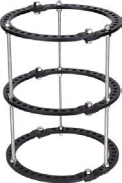 | Set |
| Lower limb lengthening external Fixator | GX301003 | 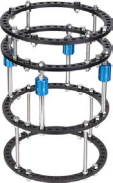 | Set |
| Tibial And Femur Fracture Ring Fixator-l | GX301004 | 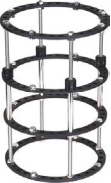 | Set |
| External Elbow Joint Fixator | GX301005 | 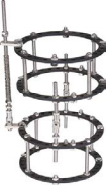 | Set |
| Tibia And Femur Fixation Orthopedics Fixator | GX301006 | 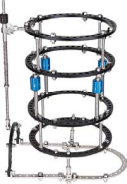 | Set |
| Taylor External Fixator | GX301007 | 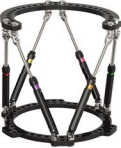 | Set |
| Knee Joint Fixator | GX301008 | 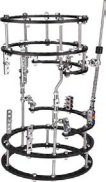 | Set |
| Ankle Joint Fixator | GX301009 | 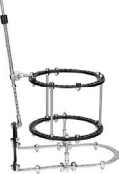 | Set |
Advantages of XC Medico's Products

CNC Preliminary Processing
The computer numerical control technology is used to precisely process orthopedic products. This process has the characteristics of high precision, high efficiency, and repeatability. It can quickly produce customized medical devices that conform to the human anatomical structure and provide patients with personalized treatment plans.
| 
Product Polishing
The purpose of orthopedic products polishing is to improve the contact between the implant and human tissue, reduce stress concentration, and improve the long-term stability of the implant. | 
Quality Inspection
The mechanical properties test of orthopedic products is designed to simulate the stress conditions of human bones, evaluate the load-bearing capacity and durability of implants in the human body, and ensure their safety and reliability. |

Product Package
Orthopedic products are packaged in a sterile room to ensure that the product is encapsulated in a clean, sterile environment to prevent microbial contamination and ensure surgical safety.
|  Product Warehouse Product Warehouse
The storage of orthopedic products requires strict in-and-out management and quality control to ensure product traceability and prevent expiration or wrong shipment. |  Sample Room Sample Room
The sample room is used to store, display and manage various orthopedic products samples for product technology exchanges and training. |
The Process To Cooperate With XC Medico
1. Ask Xc Medico Team For Tibial And Femur Fracture Ring Fixator Product Catalog.
2. Choose Your Interested Tibial And Femur Fracture Ring Fixator Product.
3. Ask For A Sample To Test Tibial And Femur Fracture Ring Fixator.
4.Make An Order Of XC Medico's Tibial And Femur Fracture Ring Fixator.
5.Become A Dealer Of XC Medico's Tibial And Femur Fracture Ring Fixator.
The Advantages To Be A Dealer Or Wholesaler Of XC Medico
1.Better Purchase Prices Of Tibial And Femur Fracture Ring Fixator.
2.100% The Highest Quality Tibial And Femur Fracture Ring Fixator.
3. Less Ordering Efforts.
4. Price Stability For The Period Of Agreement.
5. Sufficient Tibial And Femur Fracture Ring Fixator.
6. Quick And Easy Assessment Of XC Medico's Tibial And Femur Fracture Ring Fixator.
7. A Globally Recognized Brand - XC Medico.
8. Fast Access Time To XC Medico Sales Team.
9. Additional Quality Test By XC Medico Team.
10. Track Your XC Medico Order From Start To Finish.
Tibial And Femur Fracture Ring Fixator: A Comprehensive Guide
The Tibial and Femur Fracture Ring Fixator is a revolutionary device in the field of orthopedic surgery, designed to address complex and challenging fractures in the lower extremities. This comprehensive guide explores its features, applications, advantages, and future trends to provide an in-depth understanding for medical professionals, students, and researchers.
What is Tibial And Femur Fracture Ring Fixator?
The Tibial and Femur Fracture Ring Fixator is an external fixation system used to stabilize and support fractures of the tibia and femur. Unlike traditional plating or intramedullary nailing methods, this device operates externally, minimizing the risk of soft tissue damage and infection. It utilizes a system of circular or semi-circular rings connected by rods and wires, which provide multidirectional support to the fractured bone segments.
This device is particularly effective for treating complex fractures, such as comminuted, open, or infected fractures, where internal fixation may not be suitable. Its adjustable design allows surgeons to precisely align and maintain bone fragments during the healing process.
Tibial And Femur Fracture Ring Fixator Features
Circular Ring System
The interconnected rings provide 360-degree stability, accommodating various fracture configurations.
Adjustable Rods and Wires
These components allow for real-time modifications to alignment, ensuring precise anatomical restoration.
Minimally Invasive Application
The device is applied externally, reducing the need for large incisions and minimizing tissue trauma.
Multiplanar Fixation
It offers support in multiple planes, enhancing fracture stability and allowing weight-bearing activities earlier in recovery.
Modularity
The system can be customized based on fracture type and patient anatomy, ensuring a patient-specific approach.
Tibial And Femur Fracture Ring Fixator Advantages
Enhanced Stability
The circular configuration provides superior stability, even in unstable fractures.
Soft Tissue Preservation
The external application avoids unnecessary disruption of soft tissues and blood supply, promoting faster healing.
Reduced Infection Risk
Its external nature minimizes the risk of deep infections, especially in open fractures.
Customizable Adjustments
Surgeons can modify the fixation construct postoperatively without additional surgery, accommodating changes during the healing process.
Facilitates Bone Lengthening
The fixator is also widely used in limb lengthening and deformity correction procedures.
Tibial And Femur Fracture Ring Fixator Treatment of Fracture Types
Comminuted Fractures
For fractures with multiple bone fragments, the ring fixator provides stability while allowing soft tissue healing.
Open Fractures
The external nature of the fixator prevents the introduction of foreign materials into the wound, reducing infection risk.
Infected Fractures
It supports fracture healing while facilitating the treatment of underlying infections.
Segmental Defects
The system can bridge large bone gaps, promoting regeneration through distraction osteogenesis.
Pediatric Fractures
Its minimally invasive application is particularly advantageous for growing bones.
Risks of Tibial And Femur Fracture Ring Fixator Surgery
Pin Tract Infections
Infection at the wire or pin insertion sites is a common issue, requiring diligent care and monitoring.
Soft Tissue Irritation
Prolonged external fixation may cause discomfort or irritation to the surrounding tissues.
Malalignment
Inadequate adjustments during or after surgery can lead to improper bone alignment, requiring corrective interventions.
Delayed Union or Non-Union
In some cases, fractures may fail to heal within the expected timeframe.
Psychological Impact
The visible and cumbersome nature of the device may affect patient compliance and mental well-being.
Tibial And Femur Fracture Ring Fixator Future Marke
Technological Advancements
Innovations in materials and design, such as lightweight and bioresorbable components, are enhancing device functionality.
Rising Fracture Incidence
Increasing rates of road accidents, sports injuries, and osteoporosis-related fractures are driving demand.
Global Aging Population
As the elderly population grows, so does the need for effective fracture management solutions.
Emerging Markets
Developing countries are witnessing increased adoption of advanced orthopedic technologies, contributing to market expansion.
Summary
The Tibial and Femur Fracture Ring Fixator is a transformative solution in orthopedic surgery, offering unmatched stability and versatility for managing complex lower extremity fractures. Its innovative design, coupled with numerous advantages, makes it a valuable asset for surgeons and patients alike. While it carries certain risks, the benefits far outweigh the challenges, especially when applied by skilled professionals. As technology advances and market demand increases, this device will continue to play a pivotal role in shaping the future of fracture management.
Warm reminder: This article is for reference only and cannot replace the doctor's professional advice. If you have any questions, please consult your attending physician.
English
Русский
简体中文
繁體中文
العربية
Français
Español
Português
Deutsch
italiano
日本語
한국어
Nederlands
Tiếng Việt
ไทย
Polski
Türkçe
አማርኛ
ພາສາລາວ
ភាសាខ្មែរ
Bahasa Melayu
ဗမာစာ
தமிழ்
Filipino
Bahasa Indonesia
magyar
Română
Čeština
Монгол
қазақ
Српски
हिन्दी
فارسی
Kiswahili
Slovenčina
Slovenščina
Norsk
Svenska
українська
Ελληνικά
Suomi
Հայերեն
עברית
Latine
Dansk
اردو
Shqip
বাংলা
Hrvatski
Afrikaans
Gaeilge
Eesti keel
Māori
සිංහල
नेपाली
Oʻzbekcha
latviešu
অসমীয়া
Aymara
Azərbaycan dili
Bamanankan
Euskara
Беларуская мова
भोजपुरी
Bosanski
Български
Català
Cebuano
Corsu
ދިވެހި
डोग्रिड ने दी
Esperanto
Eʋegbe
Frysk
Galego
ქართული
guarani
ગુજરાતી
Kreyòl ayisyen
Hausa
ʻŌlelo Hawaiʻi
Hmoob
íslenska
Igbo
Ilocano
Basa Jawa
ಕನ್ನಡ
Kinyarwanda
गोंगेन हें नांव
Krio we dɛn kɔl Krio
Kurdî
Kurdî
Кыргызча
Lingala
Lietuvių
Oluganda
Lëtzebuergesch
Македонски
मैथिली
Malagasy
മലയാളം
Malti
मराठी
ꯃꯦꯇꯥꯏ (ꯃꯅꯤꯄꯨꯔꯤ) ꯴.
Mizo tawng
Chichewa
ଓଡ଼ିଆ
Afaan Oromoo
پښتو
ਪੰਜਾਬੀ
Runasimi
Gagana Samoa
संस्कृत
Gaelo Albannach
Sepeti
Sesotho
chiShona
سنڌي
Soomaali
Basa Sunda
Wikang Tagalog
Тоҷикӣ
Татарча
తెలుగు
ትግንያውያን
Xitsonga
Türkmençe
संस्कृत
ئۇيغۇرچە
Cymraeg
isiXhosa
ייִדיש
Yorùbá
isiZulu
























 Product Warehouse
Product Warehouse Sample Room
Sample Room









